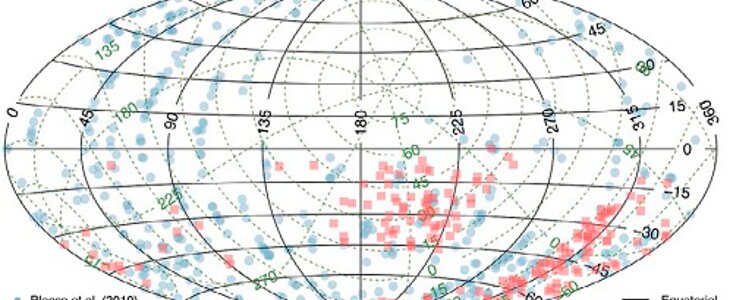Making Good Use of Bad Weather: Finding Metal-poor Stars Through the Clouds
17 Abril 2019
The Gemini telescopes helped identify low-metallicity stars by gathering medium-resolution spectroscopic GMOS data for 666 bright stars under poor weather conditions. These data provide a unique opportunity to explore the chemical evolution of the Milky Way and look at the enrichment of star-forming gas clouds in the early Universe.
Low-metalicity stars (stars with less than 1% of the elements heavier than Hydrogen and Helium than the Sun contains) are the Rosetta Stones of stellar astrophysics. Encoded in the atmosphere of these low-mass, long-lived relics are the signatures of the processes by which the first chemical elements were cooked up, perhaps as early as a few tens of millions of years after the Big Bang. These stars are believed to be the direct descendants of the first stars to be born in the Universe, which were massive and short-lived. Hence, second-generation, low-metallicity stars are the artifacts which help us write the ancient chemical history of the Universe.
In particular, the Extremely Metal-Poor stars (EMP - with iron abundances of 1/1,000 of the solar value) are believed to carry in their atmospheres the chemical fingerprints of the evolution of as few as one first-generation massive star. EMP stars are intrinsically rare (less than 30 stars identified to date with iron abundances of 1/10,000 of the solar value) and the majority (more than 60%) show a very strong molecular carbon signature in their optical spectrum. The low-metallicity and strong carbon also affect the colors of these stars in optical wavelengths. Taking advantage of this, we were able to preselect bright candidates from two public stellar databases — the RAdial Velocity Experiment (RAVE) and the Best & Brightest Survey (B&B). We then used the Gemini Multi-Object Spectrograph (GMOS; North and South) with the B600 gratings and 1-arcsecond slits to obtain the spectra of 666 stars (see Figure 1).
In total, seven GMOS Poor Weather programs were executed (three in the North and four in the South) spanning four semesters (from 2015A to 2016B). Those programs had 310 hours of allocated time, and, assuming the 666 targets took 222 hours of observing time, the efficiency was around 72%, meaning that only 28% of the already poor weather was lost, which is a great accomplishment for the program and the Observatory.
The spectra gathered at Gemini/GMOS are of sufficient quality (signal-to-noise ratios and spectral resolution) to allow for the determination of stellar atmospheric parameters: effective temperature, surface gravity, metallicity, and carbon abundance. A subset of these stars were then re-observed in higher-resolution, so it was possible to determine their full chemical abundance pattern. There is already a study published based on the extremely metal-poor star J2005-3057, first identified at Gemini (Cain et al., 2018). We are also gathering high-resolution data for the most carbon-enhanced stars identified by Gemini and the results are also promising. In the near future, such bright stars will be perfect targets for high-resolution spectroscopic follow-up with GHOST, which will be a great asset in pushing these efforts forward.
Enlaces
- Article published in the April 2019 issue of GeminiFocus by Principal Investigator Vinicius Placco of the University of Notre Dame.
- The original papers were published in The Astrophysical Journal and The Astronomical Journal.


